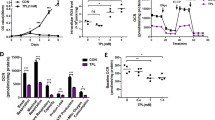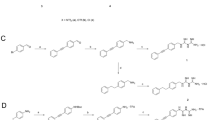Abstract
Mantle cell lymphoma (MCL) is characterized by the uncontrolled overexpression of cyclin D1. Styryl sulfonyl compounds have shown potent antitumor activity against MCL by inducing cell-cycle arrest and apoptosis. However, the exact molecular mechanism by which these compounds function is yet to be elucidated. Here, we show that the prototypical styryl sulfonyl compound ON 01910.Na decreased cyclin D1 and c-Myc protein levels in MCL cells, whereas mRNA levels of cyclin D1 were minimally affected. Notably, ON 01910.Na suppressed eukaryotic translation initiation factor 4E (eIF4E)-mediated cyclin D1 mRNA translation, decreased levels of phosphorylated Akt, mammalian target of Rapamycin (mTOR) and eIF4E-binding protein (eIF4E-BP), lowered the cap site binding activity of eIF4E and directly inhibited activity of phosphatidylinositol-3 kinase (PI-3K). Analysis of apoptotic signaling pathways revealed that ON 01910.Na induced the release of cytochrome c from mitochondria, altered expression of Bcl-2 family of proteins and stimulated activation of caspases. Taken together, styryl sulfonyls can cause a rapid decrease of cyclin D1 by blocking cyclin D1 mRNA translation through inhibition of the PI-3K/Akt/mTOR/eIF4E-BP signaling pathway and triggering a cytochrome c-dependent apoptotic pathway in MCL cells.
This is a preview of subscription content, access via your institution
Access options
Subscribe to this journal
Receive 50 print issues and online access
$259.00 per year
only $5.18 per issue
Buy this article
- Purchase on Springer Link
- Instant access to full article PDF
Prices may be subject to local taxes which are calculated during checkout








Similar content being viewed by others
References
Adams JM, Cory S . (2007). Bcl-2-regulated apoptosis: mechanism and therapeutic potential. Curr Opin Immunol 19: 488–496.
Alam A, Cohen LY, Aouad S, Sekaly RP . (1999). Early activation of caspases during T lymphocyte stimulation results in selective substrate cleavage in nonapoptotic cells. J Exp Med 190: 1879–1890.
Aoki M, Jiang H, Vogt PK . (2004). Proteasomal degradation of the FoxO1 transcriptional regulator in cells transformed by the P3k and Akt oncoproteins. Proc Natl Acad Sci USA 101: 13613–13617.
Armengol G, Rojo F, Castellvi J, Iglesias C, Cuatrecasas M, Pons B et al. (2007). 4E-binding protein 1: a key molecular ‘funnel factor’ in human cancer with clinical implications. Cancer Res 67: 7551–7555.
Bertoni F, Ponzoni M . (2007). The cellular origin of mantle cell lymphoma. Int J Biochem Cell Biol 39: 1747–1753.
Bertoni F, Rinaldi A, Zucca E, Cavalli F . (2006). Update on the molecular biology of mantle cell lymphoma. Hematol Oncol 24: 22–27.
Brady SC, Allan LA, Clarke PR . (2005). Regulation of caspase 9 through phosphorylation by protein kinase C zeta in response to hyperosmotic stress. Mol Cell Biol 25: 10543–10555.
Brauns SC, Dealtry G, Milne P, Naude R, Van de Venter M . (2005). Caspase-3 activation and induction of PARP cleavage by cyclic dipeptide cyclo(Phe-Pro) in HT-29 cells. Anticancer Res 25: 4197–4202.
Campo E, Raffeld M, Jaffe ES . (1999). Mantle-cell lymphoma. Semin Hematol 36: 115–127.
de Leeuw RJ, Davies JJ, Rosenwald A, Bebb G, Gascoyne RD, Dyer MJ et al. (2004). Comprehensive whole genome array CGH profiling of mantle cell lymphoma model genomes. Hum Mol Genet 13: 1827–1837.
Dhanasekaran DN, Reddy EP . (2008). JNK signaling in apoptosis. Oncogene 27: 6245–6251.
Elmore S . (2007). Apotosis: a review of programmed cell death. Toxicol pathol 35: 495–516.
Ely S, Di Liberto M, Niesvizky R, Baughn LB, Cho HJ, Hatada EN et al. (2005). Mutually exclusive cyclin-dependent kinase 4/cyclin D1 and cyclin-dependent kinase 6/cyclin D2 pairing inactivates retinoblastoma protein and promotes cell cycle dysregulation in multiple myeloma. Cancer Res 65: 11345–11353.
Fresno Vara JA, Casado E, de Castro J, Cejas P, Belda-Iniesta C, Gonzalez-Baron M . (2004). PI3K/Akt signalling pathway and cancer. Cancer Treat Rev 30: 193–204.
Gingras AC, Raught B, Sonenberg N . (2001). Regulation of translation initiation by FRAP/mTOR. Genes Dev 15: 807–826.
Gumireddy K, Reddy MV, Cosenza SC, Boominathan R, Baker SJ, Papathi N et al. (2005). ON01910, a non-ATP-competitive small molecule inhibitor of Plk1, is a potent anticancer agent. Cancer Cell 7: 275–286.
Kawamata N, Chen J, Koeffler HP . (2007). Suberoylanilide hydroxamic acid (SAHA; vorinostat) suppresses translation of cyclin D1 in mantle cell lymphoma cells. Blood 110: 2667–2673.
Kim R . (2005). Recent advances in understanding the cell death pathways activated by anticancer therapy. Cancer 103: 1551–1560.
Kozopas KM, Yang T, Buchan HL, Zhou P, Craig RW . (1993). MCL1, a gene expressed in programmed myeloid cell differentiation, has sequence similarity to BCL2. Proc Natl Acad Sci USA 90: 3516–3520.
Leroux D, Le Marc’Hadour F, Gressin R, Jacob MC, Keddari E, Monteil M et al. (1991). Non-Hodgkin's lymphomas with t(11;14)(q13;q32): a subset of mantle zone/intermediate lymphocytic lymphoma? Br J Haematol 77: 346–353.
Liao DJ, Thakur A, Wu J, Biliran H, Sarkar FH . (2007). Perspectives on c-Myc, cyclin D1, and their interaction in cancer formation, progression, and response to chemotherapy. Crit Rev Oncog 13: 93–158.
Lin S, Wang W, Wilson GM, Yang X, Brewer G, Holbrook NJ et al. (2000). Down-regulation of cyclin D1 expression by prostaglandin A(2) is mediated by enhanced cyclin D1 mRNA turnover. Mol Cell Biol 20: 7903–7913.
Luo X, Budihardjo I, Zou H, Slaughter C, Wang X . (1998). Bid, a Bcl2 interacting protein, mediates cytochrome c release from mitochondria in response to activation of cell surface death receptors. Cell 94: 481–490.
Martin SA, Ouchi T . (2005). BRCA1 phosphorylation regulates caspase-3 activation in UV-induced apoptosis. Cancer Res 65: 10657–10662.
Mattoon DR, Lamothe B, Lax I, Schlessinger J . (2004). The docking protein Gab1 is the primary mediator of EGF-stimulated activation of the PI-3K/Akt cell survival pathway. BMC Biol 2: 24.
Osaki M, Oshimura M, Ito H . (2004). PI3K-Akt pathway: its functions and alterations in human cancer. Apoptosis 9: 667–676.
Park IW, Reddy MV, Reddy EP, Groopman JE . (2007). Evaluation of novel cell cycle inhibitors in mantle cell lymphoma. Oncogene 26: 5635–5642.
Prasad A, Qamri Z, Wu J, Ganju RK . (2007). Slit-2/Robo-1 modulates the CXCL12/CXCR4-induced chemotaxis of T cells. J Leukoc Biol 82: 465–476.
Raught B, Gingras AC . (1999). eIF4E activity is regulated at multiple levels. Int J Biochem Cell Biol 31: 43–57.
Reddy MV, Mallireddigari MR, Cosenza SC, Pallela VR, Iqbal NM, Robell KA et al. (2008). Design, synthesis, and biological evaluation of (E)-styrylbenzylsulfones as novel anticancer agents. J Med Chem 51: 86–100.
Rizzatti EG, Falcao RP, Panepucci RA, Proto-Siqueira R, Anselmo-Lima WT, Okamoto OK et al. (2005). Gene expression profiling of mantle cell lymphoma cells reveals aberrant expression of genes from the PI3K-AKT, WNT and TGFbeta signalling pathways. Br J Haematol 130: 516–526.
Rosenwald A, Wright G, Wiestner A, Chan WC, Connors JM, Campo E et al. (2003). The proliferation gene expression signature is a quantitative integrator of oncogenic events that predicts survival in mantle cell lymphoma. Cancer Cell 3: 185–197.
Rosenwald IB, Kaspar R, Rousseau D, Gehrke L, Leboulch P, Chen JJ et al. (1995). Eukaryotic translation initiation factor 4E regulates expression of cyclin D1 at transcriptional and post-transcriptional levels. J Biol Chem 270: 21176–21180.
Rosenwald IB, Lazaris-Karatzas A, Sonenberg N, Schmidt EV . (1993). Elevated levels of cyclin D1 protein in response to increased expression of eukaryotic initiation factor 4E. Mol Cell Biol 13: 7358–7363.
Ruggero D, Montanaro L, Ma L, Xu W, Londei P, Cordon-Cardo C et al. (2004). The translation factor eIF-4E promotes tumor formation and cooperates with c-Myc in lymphomagenesis. Nat Med 10: 484–486.
Shi Y, Sharma A, Wu H, Lichtenstein A, Gera J . (2005). Cyclin D1 and c-myc internal ribosome entry site (IRES)-dependent translation is regulated by AKT activity and enhanced by rapamycin through a p38 MAPK- and ERK-dependent pathway. J Biol Chem 280: 10964–10973.
Vermeulen K, Van Bockstaele DR, Berneman ZN . (2005). Apoptosis: mechanisms and relevance in cancer. Ann Hematol 84: 627–639.
Wendel HG, De Stanchina E, Fridman JS, Malina A, Ray S, Kogan S et al. (2004). Survival signalling by Akt and eIF4E in oncogenesis and cancer therapy. Nature 428: 332–337.
Witzig TE . (2005). Current treatment approaches for mantle-cell lymphoma. J Clin Oncol 23: 6409–6414.
Yoder-Hill J, Pause A, Sonenberg N, Merrick WC . (1993). The p46 subunit of eukaryotic initiation factor (eIF)-4F exchanges with eIF-4A. J Biol Chem 268: 5566–5573.
Zucca E, Roggero E, Pinotti G, Pedrinis E, Cappella C, Venco A et al. (1995). Patterns of survival in mantle cell lymphoma. Ann Oncol 6: 257–262.
Acknowledgements
This work was supported by a charitable contribution from Mr and Mrs Henryk and Rochelle Schwarz and SBIR grant # 1 R43 CA134108-01A1. E Premkumar Reddy was supported by grant CA109820. Disclosure: Dr Groopman is a consultant to Onconova Therapeutics, Inc.
Author information
Authors and Affiliations
Corresponding author
Rights and permissions
About this article
Cite this article
Prasad, A., Park, IW., Allen, H. et al. Styryl sulfonyl compounds inhibit translation of cyclin D1 in mantle cell lymphoma cells. Oncogene 28, 1518–1528 (2009). https://doi.org/10.1038/onc.2008.502
Received:
Revised:
Accepted:
Published:
Issue Date:
DOI: https://doi.org/10.1038/onc.2008.502
Keywords
This article is cited by
-
Effects of rigosertib on the osteo-hematopoietic niche in myelodysplastic syndromes
Annals of Hematology (2019)
-
Novel Therapies for Acute Myeloid Leukemia: Are We Finally Breaking the Deadlock?
Targeted Oncology (2017)
-
Rigosertib as a selective anti-tumor agent can ameliorate multiple dysregulated signaling transduction pathways in high-grade myelodysplastic syndrome
Scientific Reports (2014)
-
Phenotypic screening in cancer drug discovery — past, present and future
Nature Reviews Drug Discovery (2014)
-
Phase I study of ON 01910.Na (Rigosertib), a multikinase PI3K inhibitor in relapsed/refractory B-cell malignancies
Leukemia (2013)



